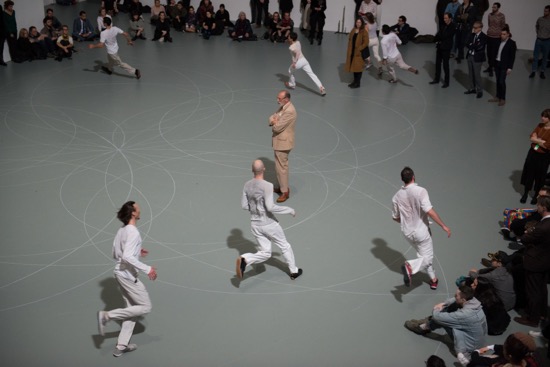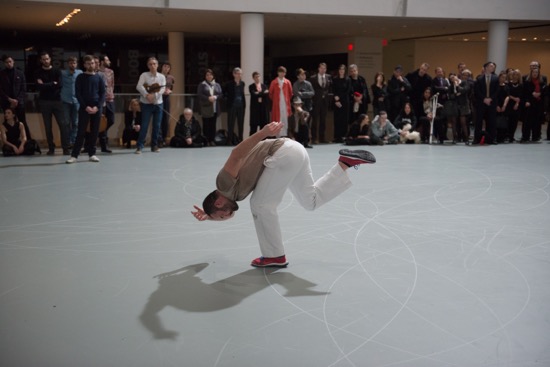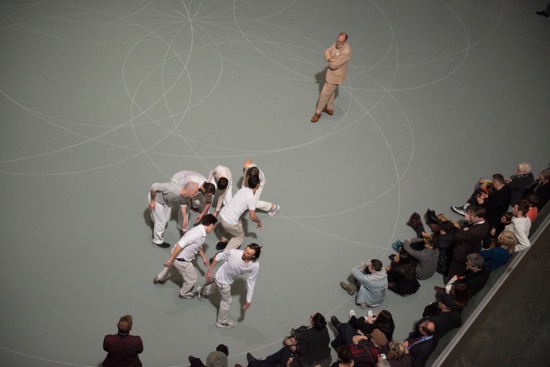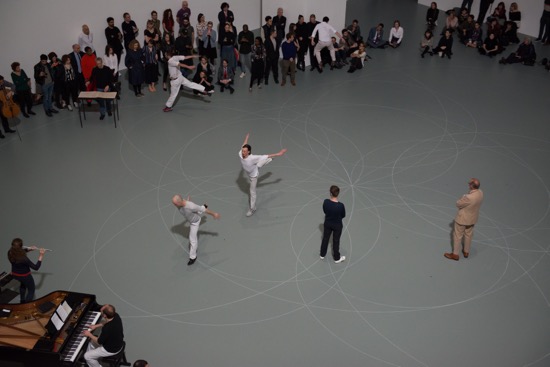Anne Teresa De Keersmaeker’s Work/Travail/Arbeid at the Museum of Modern Art, March 29-April 2.

Members of Rosas in Work/Travail/Arbeid/. Counter-clockwise from bottom left: Igor Shyshko, Carlos Garbin, Böstjan Antončič, Julien Monty, Samantha van Wissen, Marie Goudot, and Michaël Pomero. Photo: Anne Van Aerschot
Decades ago, I could visit the Museum of Modern Art free whenever I wanted (it was a privilege granted to those of us who lived a bit west of MOMA at the Rehearsal Club, a residence for “young women in the theater”). In warm weather, I could drop in and prowl the Sculpture Garden—eyeing, if I wished, the hind end of Picasso’s “She-Goat”; gazing at a marble nymph poised to fall into a pool (Aristide’s Maillol’s “The River”) from several viewpoints; and realizing that the huge arrogant bronze that Rodin made of Balzac was probably best seen from the front.
I thought about that while in MOMA’s lobby after hours, waiting to take the escalator to the atrium where the invitational preview of Anne Teresa De Keersmaeker’s Work/Travail/Arbeid was to be held; the statues were visible through the wall of windows. I was there to see what was labeled an exhibition, taking place in a large, open area, where we were free to come and go, as well as to move around and see the event from different angles. Both viewers and viewed, we could get far closer to the “artworks” than a proscenium stage permits. For about an hour, De Keersmaeker; dancers in her Brussels-based company, Rosas; and musicians in the collaborating ensemble Ictus, presented a deconstruction of her Vortex Temporum, which I saw at the Brooklyn Academy of Music, last October. (www.artsjournal.com/dancebeat/2016/10/past-present-and-future-meet-in-a-whirlpool/ ).
The material may be the same, but our experience of it differs greatly. Imagine that a dancer has come extremely close to you, as Boštjan Antončič does in the solo that opened this particular installation—putting a hand on one spectator’s shoulder, then another’s. Imagine knowing that one of these extraordinary performers suddenly sees you. If you’re standing, you may have to step back; sitting on the floor, you may have to get your feet out of the way. At one point, tall, rangy Igor Shyshko, launched himself into the air inches from my knee and leaped over the stretched-out legs of the woman next to me. My heartbeat jumped with him.
Six one-hour sequences are performed each day the exhibition is on view at MOMA (March 29-April 2) eight sequences on Friday; but the order and performers vary. At the preview on March 28th, most spectators arrived at the same time and stayed close to the atrium’s walls; only some of them moved around the room to get new perspectives. Those who stayed within the design chalked on the floor happened to be people associated with the company. On subsequent days, the experience would possibly be more fluid, and the space not always crowded. I can imagine spectators getting more involved. Never mind. We were nearer to this absorbing dance and music collaboration than we usually are as theater-goers.
De Keersmaeker and her colleagues created Vortex Temporum (2013) through intense formal strategies—spatial, arithmetical, geometrical, and spiritual, although unless spectators have read about her creative process, they may not always understand what these are. They might also not realize that, in some way, each dancer in Rosas is relating closely to the sounds produced by one of the Ictus musicians. However, they surely sense in some deep way that this is a universe with rules, that we are seeing an aural language and a visual one being passed back and forth. Suspense is in the air.
The pattern chalked on the gray floor resembles a huge mandala of variousky sized interlocking circles, contained within an invisible pentagon. During a pause, De Keersmaeker aids our understanding of this design and the process behind it: one dancer temporarily anchors the end of an appropriate length of string to the floor, while a colleague at the other end of it re-chalks a circle.

Boštjan Antončič’s solo in Anne Teresa De Keersmaeker’s Work/Travail/Arbeid at the Museum of Modern Art. Photo: Anne Van Aerschot
On this particular evening, Antončič’s solo is a marvel. You can imagine that he’s performing a lexicon of all the diverse movements that we will see—whether leaning and twisting to look over his shoulder, swinging his legs around in bold, space-devouring steps, staggering, lunging, spinning, jumping, racing on curved paths, dragging himself along the floor on his hands, and more. He doesn’t seem to follow complete circles on the floor, but (maybe) slips from the curves of one onto those belonging to another.
He’s “speaking” in a language we want to understand—one with breath-suspended pauses, changes of tempo, contrasts in scale and density. We may infer drama where none is intended. Is he, looking over his shoulder, fleeing from something, or, gazing ahead, perhaps hastening toward something ? Is a disturbance in the weather pushing him off balance or onto a new path? The fact that he veers close to us incites such thoughts; we see his breathing and the sweat that darkens his tee shirt and glistens on his face.
But I’ve only mentioned of the visual component, and the aural one is intimately linked to it. Antončič is paired with violinist Igor Semenoff, who stands on one side of the atrium to play the corresponding section of Gérard Grisey’s 1996 Vortex Temporum. The music’s sudden, violently plucked notes, its tempests, and its skirmishes accord with the structure of the dance, but also impart drama—or, at least, intent—to it. You can imagine that, say, a sudden stroke that Semenoff makes on his instrument (holding it low and whisking his bow high into the air) has “caused” Antončič to make a certain move. The program note puts it this way: “each dancer is ‘played by’ the music.” You can also believe that Semenoff is responding to Antončič. But in reality their relationship is not a power struggle but a shared composition by paired artists expressing the same ideas simultaneously in their respective fields.
A black Steinway is moved into position at one edge of the space, and the members of Ictus incorporate it into their semi circle. Semenoff and his violin join Jean-Luc Plouvier (piano), Chryssi Dimitriou (flute), Dirk Descheemaeker (clarinet), Jeroen Robbrecht (viola), Geert de Bièvre (cello). They play initially without a conductor. Grisey was part of the 20th-century movement in music known as Spectralism. I cannot begin to explain the complexities of this, but can say that it foregrounds timbre; we focus on the sonorous quality of each instrument, but also hear clouds of sound, whirlpools of sound, slow plodding rhythms, fugitive melodies, and a jittering so high and dense that we might be inside a swarm of mosquitoes. Sometimes the music assaults our ears; sometimes we can hardly hear a bow being drawn across a string. A program note explains that Grisey investigated three aspects of temporality that interested him: “the time of humans” (related to breath), “the time of whales” (time expanded), and “the time of insects” (time contracted).

Clustering (clockwise from foreground): Igor Shyshko, Julien Monty, Carlos Garbin, Boštjan Antončič, Marie Goudot, Samantha van Wissen, Michäel Pomero. Photo: Anne Van Aerschot
Immediately after this, six dancers replace the six musicians and, in silence and without traveling much from their respective places, create the visual equivalent of what we just heard. Slowly, they bend, slowly they lunge, twisting to glance up and over their shoulders. But you can notice patterns building. Michaël Pomero raises a fist, begins to move, and gradually impels others to join. Julien Monty becomes busy, and Antončič merges into unison with him. On the other side of the piano, Carlos Garbin, Cynthia Loemij, and Marie Goudot are less active for while—that is, until Garbin introduces a cat-like jump, his knees bending in the air (the others stop and watch him). Your eyes dart around, grasping this dodgy counterpoint. The music we don’t hear has produced an image of movement as a kind of virus: it’s catching.
This sequence ends when all exit but Garbin, and now we know for sure what instrument he is paired with: Plouvier takes his place at the piano, and they both perform boldly and with clarity. Perhaps to make certain we recognize their close association, Garbin darts over to the piano and pounces on a few chords. Plouvier retreats for several seconds and then repossesses his instrument. By now I’m sitting on the floor close enough to watch the dance of the pianist—how he crouches over his keyboard, fingers at lightning speed, then smacks down on particular chords, or whips one hand into the air as if he has clawed a particular note out of the Steinway.

Looking down on Anne Teresa De Keersmaeker’s Work/Travail/Arbeid at the Museum of Modern Art. Bottom left: flautist Chryssi Dimitriou and pianist Jean-Luc Plouvier. Visible above them: cellist Geert De Bièvre and music director Georges-Elie Octors. Dancers (clockwise from bottom left): Carlos Garbin, Igor Shyshko, Boštjan Antončič, and Julien Monty. Photo: Anne Van Aerschot
The piano has another way of illustrating a vortex. While the dancers and the other musicians prowl, music director Georges-Elie Octors propels the instrument in a path that circles the room, spiraling as it goes. Amazingly, Plouvier walks along with it, playing Grisey’s music (fortunately not a part of it that’s too fast or complex) and helping out with tricky maneuvers. The speed of the piano’s journey picks up, just as a whirlpool appears to move faster at its center. Audience members know enough to move out of the way. Now and then a dancer calls out a number.
Two additional dancers (Shyshko and Samantha van Wissen) join the others, I’m not sure why. (Is one dancer not enough for a two-handed pianist? Has van Wissen replaced Loemij?) The musicians move to a new spot on the periphery, and Octors, a score in front of him, prepares to lead them. (I notice that the group of two or three MOMA staff members, who’ve been looking down on the exhibition from an open passageway above, has morphed into an attentive, black-garbed flock).
One new feature of this last section is the dancers’ tendency to cluster and then race apart like a flock of birds. And they all but fly—hopping, jumping, sashaying, leaping (you can believe that Pomero does fly). If they circle, it’s always counterclockwise. The lighting provides its own signals, unexpectedly dimming a bit, then becoming very, very bright. Only the stringed instruments have been playing for a while, but now the piano joins in something like a dead march, the wind instruments quaver, the violin gets scratched. Everything slows down, and the dancers stay closer together, casting their shadows on the floor.
All that I have described above should be considered simply as a sample of what a visitor to MOMA at any given hour or hours of the day might experience looking at this miraculous sonic, seldom-still exhibition. The time structure imparts a kind of fragility to what you may see. Those statues in the sculpture garden are captives. Leave them and come back months later; they’ll be waiting. De Keersmaeker’s people don’t stick around. Because of this, and perhaps also because they have been so close to us—so like us, yet unlike us—I feel both sad and exhilarated. A visitor to MOMA could well get hooked; you know, take a coffee and sandwich break, look at a favorite painting or two, buy a book, and go back to the atrium to see another portion of the exhibit that plays music and dances.
